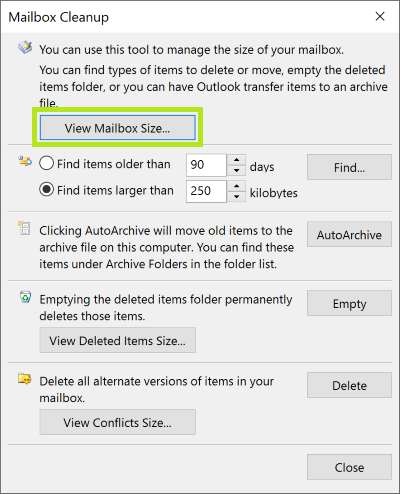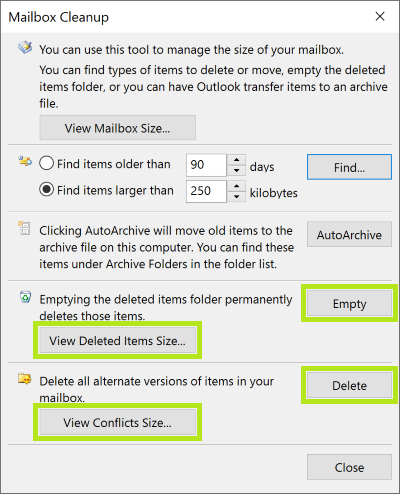When working with Outlook and using an Exchange account, you may be curious to know what the size of your current inbox is, and what your mailbox size limit might be set to. Overrunning your mailbox size can lead to corruption in your PST and, if your email is saved on a server like Exchange, your administrator might start limiting functionality after a certain volume of mail is reached. Administrators can send warnings, or even stop you from being able to send or receive emails.
How to Find your Mailbox Size and Exchange Quota
You can check your mailbox size and Exchange quota in Outlook, but the manner in which you check that information depends on the Outlook or Exchange version you are currently using.
Checking Mailbox Size and Exchange Quota in Outlook 2010-2016
Finding this information in Outlook isn’t a difficult task and shouldn’t take up too much of your time. If you are currently using Outlook 2010 or a later version, then your mailbox size and Exchange quota will be found if you go to File > Info. If you are using Outlook 2010 or 2013 then the information will be found in the section called Mailbox Tools > Mailbox Cleanup. If you are using the most recent version of Outlook 2016 then the information will be found in the section called Mailbox Settings.

If you would like this information to be displayed in the Outlook Status bar (the bar running along the bottom of the Outlook window), then you can right click on the bar and select Quota Information.

Checking Mailbox Size and Exchange Quota in Outlook 2007
If by any chance you are still using Outlook 2007 and would like to check for the Mailbox Size and Exchange Quota then you can follow these next few steps:
- Right click on the root folder of your Mailbox. This typically looks like this: “Mailbox – <your name>”
- Now click on Properties.
- Click on Folder Size…
- When working in the Cached Exchange Mode, you will be able to see two tabs in the dialog box. Choose the Server Data
- This will show you your mailbox size.
Unfortunately in Outlook 2007 and earlier versions there’s no direct way to check the Quota. You will most likely have to ask an Exchange Admin to get the information.
Outlook on the Web
If you have access to Outlook on the Web or OWA then you will also be able to find your Mailbox Size and the Exchange Quota information. Here’s how to check in the different versions of the Exchange server:
- Exchange 2007 and Exchange 2010, you can simply hover over the name of the mailbox and a little Tool Tips will appear and show your current mailbox size and quota.
- Exchange 2013 you can click on the little gear icon, found in the top right corner on the left hand side of Name > Options > Account.
- Exchange 2016 and Office 365 Exchange Online also has a little gear icon in the top right corner, on the left hand side of Image > Options, then within the Options page General > My Account. You will find the information on the bottom right hand side of the My Account page.
Now you know how to check for the Mailbox Size and Exchange Quota on all versions of Outlook.
Manage Mailbox Size
So what do you do if your Mailbox is getting a little too full? Outlook has a bunch of options to help you manage the size of your mailbox. In Outlook 2010-2013, navigate to Mailbox Cleanup as per the instructions above.
From here, you can archive items by using AutoArchive, view the size of and empty your Deleted Items folder. View the size of your Conflicts folder and delete this folder too. Outlook should already automatically archive older emails (unless your system administrator has removed this ability), so you shouldn’t need to do too much manual archiving.

A couple of other things you can do to reduce your Mailbox size is to look through and delete items in your Junk folder, and to store your attachments outside of your mailbox.
Now you know everything you need to keep your Mailbox size down, and your Outlook running smoothly.



Leave a Reply